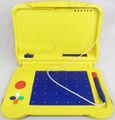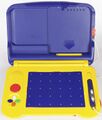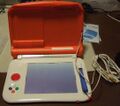Sega Pico Models
From Sega Retro
There are numerous variants of the Sega Pico console spread across the world. The console was officially supported between 1993 and 2005, and during this time many cosmetic changes and cost-cutting measures were put in place. For the most part, all models of Pico are technically identical and will run the same software. The Pico is a region-free console.
Primarily there are two variants of the Pico hardware, the more durable pre-2000 "Kids Computer Pico" (キッズコンピュータ・ピコ) models, and the post-2000 cost-reduced "Kids Communication Pico" models. There, are, however, some exceptions detailed below.
Japan
HPC-0001
The very first model of the Kids Computer Pico was the HPC-0001, a variant only released in Japan which debuted in June 1993. The HPC-0001 is a yellow with a red base, and has a dash of dark blue. It is one of two models to have the unused DE-9 port on the side.
HPC-0003
The HPC-0003 release was a revised version of the previous HPC-0001 version of the console, with a few minor tweaks to the bodywork that debuted in mid-to-late 1993 (mainly the removal of the DE-9 port). No HPC-0002 model was released to the public.
No more DE-9 port
HPC-0003A
The HPC-0003A is a very rare update to the HPC-0003, released sometime in 1993. It is rumoured to have been targeted at schools, though this comment may be referring to the similar IMC-001 model by Imagineer. This version uses the color scheme that was used with its North American and European counterparts, being cyan and purple. It is, however, the only Sega-branded Japanese model to adopt this colour scheme.
HPC-0007
Sega released the HPC-0007 sometime in 1993, which would become the "standard" Pico model for many years to come. It is largely identical to the HPC-0003, but the middle piece of plastic was changed to dark blue. Initial Asian and South Korean models of the Pico are based on the HPC-0007.
HPC-0008
In 2000, distribution rights were moved from Sega to Sega Toys, and light rebranding occurred. It is assumed HPC-0008 models were churned out quickly in preparation for the redesigned Kids Communication Pico. Alternatively it may have been repackaged leftover stock from other Asian markets.
HPC-0009
The most important change for the Pico occurred in 2001, when Sega Toys launched the Kids Communication Pico. Communication Picos are lighter models without thick blastic bases - they are supported instead by a thinner piece of foldable plastic, making them easier to store but signficantly less durable. Two types of HPC-0009 were available at launch - orange/white, or cyan/white.
Pico Pocket Monsters
This 2004 Pico release was given a Pokémon makeover in an attempt to revive sales. It is otherwise identical to the HPC-0009.
Pico Anpanman
This particular Pico was released in 2003.
Pico Mushiking
This Pico variant was released in 2001.
Pico Hamtaro
- Pico JP HAM 1.jpg
Console and box
- Pico JP HAM 2.jpg
Console closed
- Pico JP HAM Box Front.jpg
Front of box
MIXT BOOK PLAYER COPERA
The Mixt Book Player Copera is the only unusual Pico model. It was released in 1993 by Yamaha and is based on the HPC-0001, but adds stereo sound output and an FM sound chip as well as a microphone and support for music composition. It also has two MIDI ports. Coperas are much rarer devices and its exclusive set of software is not compatible with regular Sega Picos.
HIRAMEKI MIRAI KIDS IMC-001
The Hirameki Mirai Kids IMC-001 is a rare variant of the Pico presumably based on the HPC-0003A, released by Imagineer potentially for schools. It adopts the cyan/purple colour scheme seen elsewhere.
- Pico JP HMK.jpg
Pics to probably be stoled from blog.
http://blogs.yahoo.co.jp/rig_veda/61101403.html
North America
MK49002
The MK49002 is the standard 1994 North American Sega Pico model, similar to the HPC-0007 in Japan but with a cyan/purple colour scheme. There are a few logo changes and the coloring is slightly different, but is otherwise identical.
MK49325
When Majesco were given the rights to distribute older Sega consoles in 1998, they produced this model of Pico in 1999, based on the Japanese HPC-0008. It was cheaper to manufacture, but like the Genesis 3 sales were sluggish in comparison to the original release. It can be identified by the console's non-colored logo and lack of Sega branding.
PAL Regions
Only one model of Pico is known to have been released in PAL regions, and is identical to the North American MK49002 model. The only difference is its adjustments required to work with PAL TV setups.
South Korea
Model 1
The Pico (피코) was surprisingly popular in South Korea, where it was initially distributed by Samsung from March 1995 to December 2002. This first model, being the most common, is similar to the North American and European designs, but again sports a different logo.
Model 2
A second model called Thinko (싱코) was based on the HPC-0007 and released by Samsung in 1998.
Neo Pico
The HPC-0009 Kids Communication Pico was distributed in the country by Xity Enterprise from 2003 as the "Neo Pico" (네오피코).
Asia
A version of the Japanese HPC-0007 Pico, with some branding borrowed from the European variant, was distributed in "Asia". Which specific countries received the Pico is not yet known.
| Sega Home Video Game Systems | ||||||||||||||||||||||||||||
| 83 | 84 | 85 | 86 | 87 | 88 | 89 | 90 | 91 | 92 | 93 | 94 | 95 | 96 | 97 | 98 | 99 | 00 | 01 | 02 | 03 | 04 | 05 | 06 | 07 | 08 | 09 | 10 | 11 |
|---|---|---|---|---|---|---|---|---|---|---|---|---|---|---|---|---|---|---|---|---|---|---|---|---|---|---|---|---|
| SG-1000 | SG-1000 II | Mega Drive | Mega Drive II | |||||||||||||||||||||||||
| SC-3000 | Mega-CD | Mega-CD II | Genesis 3 | |||||||||||||||||||||||||
| Sega Mark III | 32X | Dreamcast | ||||||||||||||||||||||||||
| Master System | Master System II | |||||||||||||||||||||||||||
| AI Computer | Game Gear | |||||||||||||||||||||||||||
| Saturn | ||||||||||||||||||||||||||||
| Pico | Beena | |||||||||||||||||||||||||||



































